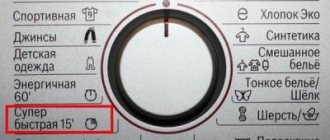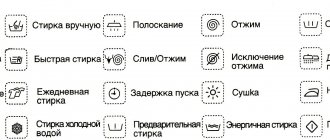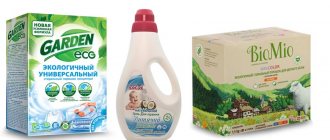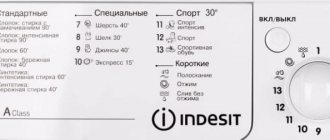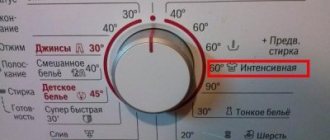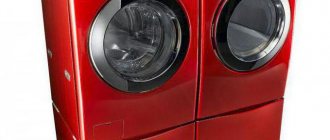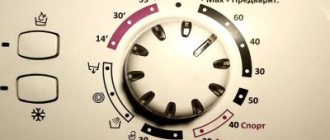- home
- Articles
- Washing machine washes with cold water
Almost all washing machine modes require washing in warm or hot water. For wool or delicate fabrics, a lower temperature is required so that the fibers are not damaged or stretched, so that the item retains its appearance after washing. If the washing machine washes with cold water when you select the normal mode, this indicates a breakdown and is a reason to contact a washing machine repairman.
Wash in cold water
All models of washing machines allow you to turn off the heating. But different machines do this differently. Somewhere you can select the water temperature “cold”, somewhere there is a temperature switch or a button to turn off the heating when selecting any washing program.
There are two reasons for forcibly turning off the heating: saving energy and caring for the fabric. If the item is not too dirty, if it does not need to be washed to remove complex stains, you can wash it in cold water. At low temperatures, the color and smoothness of the fibers are preserved. Clothes do not become covered with pills, the fabrics do not become shaggy, do not fade, or fade. Things keep their shape, do not stretch or shrink. Small holes do not form in the seams, which then turn into visible defects.
There is another unobvious advantage of washing at low temperatures - the hatch seal is not damaged and wears out less.
Of course, this does not mean that washing in hot water is not necessary. Each unit has several washing programs at different temperatures - from 30 to 90 degrees. But sometimes it happens that when you select any of these programs, the water in the drum remains the same as it comes from the water supply system.
Washing in cold water in a washing machine is a breakdown that is difficult to detect. If the unit carries out the selected program, the items will come out clean. Often, we wash not to remove difficult stains, but to simply refresh our clothes. The powder dissolves and performs its role in a liquid of any heat. High temperatures are needed to clean really dirty items, remove stains, bleach and disinfect. You can find out that unheated water is used when washing by two signs: remaining dirt and a cold glass hatch.
If you did not turn off the heating function and did not select a special washing mode, and the machine washes in ice water, you need to find out the reason and call a specialist.
Pros and cons of such a decision
When connecting hot water supply to the machine, take into account the negative aspects that the user will receive:
- Inability to use high-quality delicate mode. The machine only increases the temperature, but does not decrease it. It is impossible to use temperature conditions below 50-60 degrees.
- Accumulation of debris in the housing. Tap hot water contains a large number of chemicals and is intended for technical use only.
- The need to purchase an additional filter, which will be expensive.
- Early damage to the inlet hose. It is made of plastic, which is quickly exposed to the negative effects of hot water and the substances it contains. It is intended for cold water use only. This device will gradually have to be replaced.
There are also positive aspects to using this method. Only high-quality and well-known manufacturers produce such equipment. The most popular brands do this. They provide a long warranty.
Some consumers note that using hot water reduces the risk of developing limescale. But there are many chemicals that prevent this effect. They can be bought at any hardware store.
The issue of saving electricity is quite controversial . On the one hand, energy consumption when heating the liquid is reduced. But a person will periodically need to replace parts that deteriorate during use.
The washing machine washes with cold water: reasons
The heating element is responsible for heating the water entering the machine. This is a tubular heater that is found in every laundry appliance. The unit is connected to the cold water supply network. It takes some time to heat up to the desired temperature: depending on the power of the machine and the selected program, from 5 to 20 minutes. Therefore, if you touch the hatch and it does not heat up at least a little, perhaps the required time for heating has not yet passed. If the washing machine runs its normal cycle, the washing temperature is set to more than 30 degrees, and the hatch remains at the same temperature, then most likely the heating element has failed. It often forms scale and a layer of “dirt” from small fluff from clothes being washed, impurities in the water, and powder residues. As a result, it stops heating and heating the water. The problem is easily solved - the heating element can be replaced. This does not affect the operation of the machine in any way; after replacement, it will last for many more years. This is one of the most common problems with washing machines.
There are other reasons why a washing machine washes with cold water:
- The temperature sensor is broken. It determines how hot the liquid is in the machine and, in accordance with this, sends commands to the control unit. When it breaks, it does not recognize that the water is cold and does not give the command to heat it. If the temperature sensor is acting up, it can be replaced.
- Problems with the electronic control unit. The board elements or the tracks between them, responsible for heating, may burn out. In this case, you can replace individual parts, solder faulty tracks, or install a new control unit.
- Damage to wiring or contacts. They oxidize or wear out from prolonged use or excessive vibration if installed incorrectly. In private homes, rodents may be a problem. The wiring is changed or repaired: contacts are soldered, wires are twisted.
Types of connected washing machines
Washing machines that can be connected to hot water supply are produced by the most common brands that produce high-quality models.
These include:
- Bosch,
- Samsung
- LG,
- Philips,
- Indesit,
- Electrolux,
- Ariston,
- Vitek,
- Beko.
It is recommended to verify connectivity before purchasing. Consult the store that sells the device about this. It is better to read more about these properties in the instructions; it directly states how the installation takes place.
What to do when the machine washes with cold water
Regardless of why there is cold water in the washing machine, the problem must be corrected. To do this, call a repairman. He carries out diagnostics, finds the faulty element and replaces it. Each of the above breakdowns can be fixed easily and quickly if an experienced repairman works.
Any problems with the washing machine will be fixed by a specialist from the Top-Refit company. You can invite him to your home in Moscow at a time convenient for you.
Why you should entrust equipment repair to us:
- repair of any household appliances at home;
- there is all the equipment necessary for diagnostics and repair;
- original or manufacturer-recommended spare parts;
- affordable prices;
- neat, fast work with quality assurance.
Washing in cold water is not the most difficult problem that washing machines have. It can be easily fixed, and then the equipment will work just as well as before the repair.
What kind of washing program is this?
The “Wool” mode belongs to the category of additional programs, so you can find machines that do not have it. Although most modern units are equipped with this function.
The main feature of this program is the gentle treatment of fabric by reducing the water temperature and reducing the drum rotation speed during washing and spinning. This treatment allows you to get rid of dirt and keep the item in its original form.
The drum gently rocks from side to side, simulating hand washing . As a result, the fibers do not roll down, the product does not stretch or shrink.
Some washing machines may not have a “Wool” mode. In this case, select the “Delicate Wash” or “Gentle Wash” program.
Bonus
A significant “advantage” of hot washing is the “increase” of kilowatts. Its frequent use in everyday life greatly increases the consumption of electricity, which hurts the wallet.
If you reconsider your habits, which are hardly justified, then payment receipts will no longer be so frightening with their total amounts.
Important! When you turn on the washing machine, most of the electricity is consumed to heat the water. And this is a lot - 90% of the total.
Cold mode eliminates all these problems. So you should only use hot wash when absolutely necessary.
Subscribe to our Social networks
Drying woolen items
Features of drying woolen items:
Before you start drying, you need to read the information on the product label.- If drying is allowed, spinning should be done at a speed no higher than 400 rpm. As a rule, this applies to felt and baize.
- If drying is prohibited, to remove excess moisture after washing, wrap the item in a terry towel and gently press it without twisting it.
- Dry fabrics on a flat surface. To ensure that the water evaporates faster, things are left in a warm room with good ventilation.
- From time to time the products need to be turned over.
- In a vertical position, you can dry flannel, cloth and drape coats.
How to sort laundry for washing
To begin with, dirty clothes need to be sorted into three categories by color : light things, colored things and dark things. It is better to wash new clothes in bright colors separately the first few times: excess dye can ruin other items.
Then separate items by fabric type. The first category will include clothes made of cotton and linen: panties, pajamas, T-shirts. Secondly, delicate items made from thin fabrics. In the third - knitted socks and sweaters. The latter includes jeans and other clothes made of coarse, dense fabric. If you don't know which category to classify an item into, check the washing instructions on the label.
In order not to waste time sorting, you can put several containers for dirty laundry and separate it at once. This is especially convenient if you have a large family and do a lot of laundry.
Tips for choosing temperature and mode
Before washing, you need to study the labels on the products, sort the laundry by type of fabric and degree of soiling. This will help set the correct modes, not overload the machine with unnecessary functions, and save things from unnecessary friction.
The upper limits of the recommended modes should not be exceeded. Basic rules when choosing washing modes:
- white cotton items can be washed at the highest temperature (60-95 °), spin at maximum speed (up to 1400);
- colored items made from natural fabrics – 40 °, spin – up to 1400 rpm;
- linen - 40-60 °, spin - up to 600 rpm, for clothes turn off spin;
- synthetics and fabrics containing synthetic threads – 40 °, spin – 600 rpm;
- silk, wool, other delicate fabrics - 40°, 400-600 revolutions.
Manufacturers have thought through the operation of their products - when choosing the type of fabric, it is impossible to exceed the permissible temperature and speed.
All about water
October 2021
| Mon | W | Wed | Thu | Fri | Sat | Sun |
| " March | ||||||
| 1 | 2 | 3 | ||||
| 4 | 5 | 6 | 7 | 8 | 9 | 10 |
| 11 | 12 | 13 | 14 | 15 | 16 | 17 |
| 18 | 19 | 20 | 21 | 22 | 23 | 24 |
| 25 | 26 | 27 | 28 | 29 | 30 | 31 |
Some additions about the correct temperature to wash things at
To choose the right washing temperature, do not forget that the higher the water temperature and the more often you wash in hot water, the faster things become unusable.
Even the gentle wash cycle won't help. Therefore, even for very dirty items, it would be better to choose washing at a lower temperature.
To ensure that things are still washed efficiently, try:
- increase the amount of detergent;
- choose a better quality washing powder;
- Use a soak or prewash cycle.
If special detergents are used for washing, such as laundry shampoos, products with enzymes, products for membrane fabrics, then when choosing the washing temperature, follow the instructions on the package. Otherwise, detergents will lose their effectiveness and the washing result will not live up to expectations.
Which laundry detergent to choose
Laundry detergents are available in the form of powders, gels and capsules.
Powders remove stains well. But it will take a lot of water to rinse the powder completely. Sportswear and membrane clothing cannot be washed with powder - it can clog the pores and the fabric will lose its properties.
Laundry capsules They can be used instead of three products - stain remover, fabric softener and powder. They usually cost more than other means. Plus, you won’t be able to reduce the amount of product if you are washing not very dirty clothes or if you haven’t filled the machine completely.
Liquid gels are easy to rinse out of laundry. They are universal - they can be used for washing membrane clothes and even children's underwear, if the child does not have allergies.
It is important to measure the products correctly and put in exactly as much as is written in the instructions. If you use too little gel or powder, the laundry may not wash. If you put too much, you will need more water to rinse. To add the required amount of product, use a measuring cup.
Bleach is recommended for additional disinfection of towels, bed linen and panties.
Fabric softener can be used if desired. It softens the laundry, removes static electricity and gives the laundry a pleasant aroma. But you cannot wash sports uniforms with it - the membrane fabric may lose its properties.
How to wash so that things don’t shrink and look great?
Let’s not drag our feet and get straight to the mandatory recommendations before washing things.
So, you should divide the process of cleaning clothes using a washing machine into 5 stages:
Dirty laundry before washing. Buy a basket with holes for your home, place it in the bathroom, or where it will not attract attention and carry unpleasant odors. Holes in the basket for dirty things are needed so that stains do not become saturated with dampness and do not eat into them even more.
- Sort your clothes. Don't throw everything in one go. It is necessary to divide clothes into: black, white, colored. Distribute over tissues. Load items that are too dirty separately. Know which materials can fade a lot. Also, it is not recommended to wash shoes without a cloth inside the drum. We'll explain why later.
- Checking everything and everyone. If you don’t want to break your machine or wash your phone, check your pockets. You don’t want to wash your money or passport, right? We recommend tying your shoelaces, zipping your shoes, and leaving the buttons open. Turn your pants inside out and straighten your shirts.
- Pawn correctly. The most important rule is not to clog the machine. An overfilled drum will not wash clothes properly. Even worse - it will break. Remember: you can fill the entire drum with cotton clothes, half with synthetic clothes, and one third with wool. Pay attention to the recommendations of the manufacturer of the clothing brand. The tag always indicates the temperature, mode, and time.
Select the program and power based on the information on the label. If it is not saved, then use our guide:
- Cotton and linen – maximum rotation speed, temperature 95*
- Colored items - in water up to 60*, spin at any speed.
- Synthetics – temperature no higher than 50*, spin speed 800-900.
- Wool, silk - at a temperature of 40 *, spin at 600 rpm.
- If you know that things shed, wash them in water up to 30*.
What does a full cycle consist of?
The sequential execution of the usual stages - washing, rinsing and wringing out things - constitutes a full cycle of operation of the machine. The device allows you to regulate the specifics of these operations.
Wash
The choice of washing mode is determined by the following parameters:
- fabric structure;
- the presence of decorative elements on products;
- contamination (you can include soaking, boiling cotton fabrics).
The right choice will determine not only how well things are washed, but also possible damage to the laundry from the aggressive effects of temperature and high speeds.
Features Features
When activating the “Wool” mode when washing, you must take into account the following features:
Do not fill the drum completely. Things should not occupy more than 2/3 of its volume. Otherwise, the quality of the wash will be reduced.- The water temperature should not exceed 40 degrees. Washing in boiling water will cause irreversible damage to the product.
- It is recommended to use liquid detergents.
Gels are better rinsed from fabric fibers, dissolve faster and wash out pigment less. It would be good if the packaging was marked “For washing woolen items.” Such gels contain additives that improve the appearance of the product, for example, prevent lint from caking or have an antistatic effect. - You need to make sure that the detergent you choose is designed for use in washing machines.
- The default spin speed in most SMAs is 800 rpm. It is recommended to reduce it to 400-500 rpm, or turn it off completely.
- On most SMA models, the modes are labeled with words. Images of a ball or skein of yarn, or a box of wool can be used as symbols.
